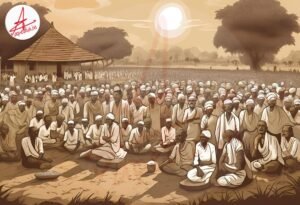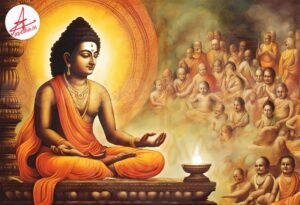Prince Siddhartha became the Buddha after renouncing his royal life.
Balances indulgence and asceticism, embraced by Buddha to attain enlightenment.
The place where the Buddha achieved enlightenment.
Explain the nature of suffering and the path to its cessation.
Provides practical steps to end suffering and achieve liberation.
Refers to the Buddha’s teachings on mindfulness, compassion, and interconnectedness.
The Buddha’s final liberation after his death at 80 years old.
The Story of Buddha’s Enlightenment
The story of Buddha’s enlightenment is foundational to the Buddhist faith, offering a narrative of personal transformation. Born as Siddhartha Gautama around 563 BCE in Lumbini (now in Nepal), he lived a privileged life as the prince of the Shakya clan. However, at age 29, his exposure to the “Four Sights” — an old man, a sick person, a corpse, and a wandering ascetic — sparked a quest to understand suffering.
Renunciation and the Path to Enlightenment
Siddhartha renounced his royal life to seek answers to suffering. After studying under spiritual teachers and practicing severe asceticism for six years, he realized that neither indulgence nor deprivation led to enlightenment. This realization formed the basis of the Middle Way, a balanced path between extremes.
The Great Awakening Under the Bodhi Tree
Siddhartha meditated under the Bodhi Tree in Bodh Gaya, where after days of deep concentration, he attained enlightenment. During this profound moment, he understood the ultimate truths of existence and overcame the temptations of Mara, the god of desire. This event is known as the Great Awakening.
The Four Noble Truths
The Buddha’s enlightenment revealed the Four Noble Truths:
- Dukkha (Suffering): Life involves suffering in many forms.
- Samudaya (Origin of Suffering): Suffering arises from craving and attachment.
- Nirodha (Cessation of Suffering): Suffering can end by overcoming cravings.
- Magga (Path to End Suffering): Following the Eightfold Path leads to liberation.
The Eightfold Path: A Practical Guide
The Eightfold Path offers a roadmap to enlightenment:
- Right View: Understanding the nature of existence.
- Right Thought: Cultivating compassion and kindness.
- Right Speech: Speaking truthfully and avoiding harmful words.
- Right Action: Acting ethically and avoiding harm.
- Right Livelihood: Earning a living without causing harm.
- Right Effort: Cultivating positive qualities.
- Right Mindfulness: Being present in the moment.
- Right Concentration: Deepening meditative focus.
Spreading the Dharma
For the next 45 years, the Buddha traveled across India, teaching the Dharma — his insights on impermanence, interdependence, and the potential for all beings to achieve enlightenment. He founded the Sangha, a community of monks, nuns, and lay followers dedicated to preserving his teachings.
The Buddha’s Parinirvana
At 80, the Buddha achieved Parinirvana, marking his final liberation from the cycle of rebirth. His teachings continue to inspire millions on their journey toward mindfulness, compassion, and spiritual awakening.








